Contents
Copper sulphate for grapes is a universal remedy that is used for feeding, preventing and treating crop diseases. Gardeners usually treat the vine with copper sulfate in spring, summer and autumn, it is important to study the rules for using the drug so as not to harm the plant.
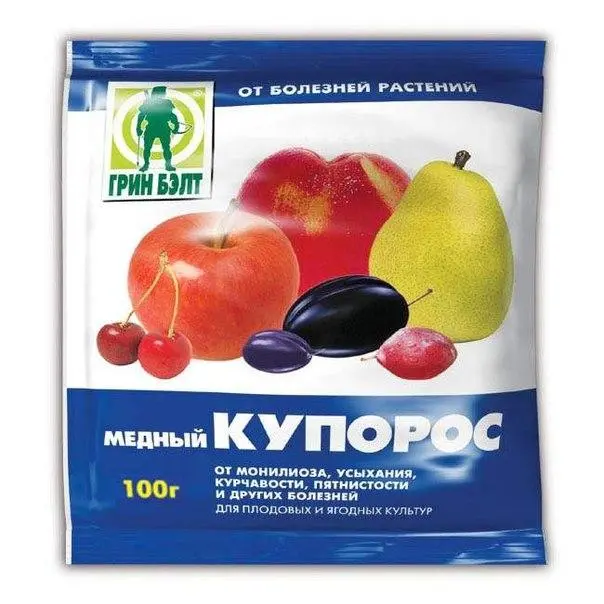
Copper sulfate will help maintain the health of the grapes
Is it possible to process grapes with copper sulfate
Before using this or that chemical, you should understand what it is and make sure that the composition is safe for plant health, in this case grapes.
Copper sulphate (CuSO4) is a combination of copper, which, like other microelements, is a good plant nutrition, and sulfuric acid salts, which can fight fungal diseases of grapes – scab, mildew, odium, etc.
Copper sulphate is a water-soluble substance that is well absorbed by plants without penetrating into fruits. This makes the drug safe for berry crops, including grapes.
All this suggests that it is possible to process grapes with copper sulfate. The main thing is to do it correctly and keep the proportions. After all, if a lack of copper can provoke a slowdown in the growth of the vine and a decrease in yield, then its excess will not bring benefits to the grapes either. At the same time, too high a concentration of a preparation containing sulfuric acid can cause burns of young shoots and leaves, and in some cases, their death.
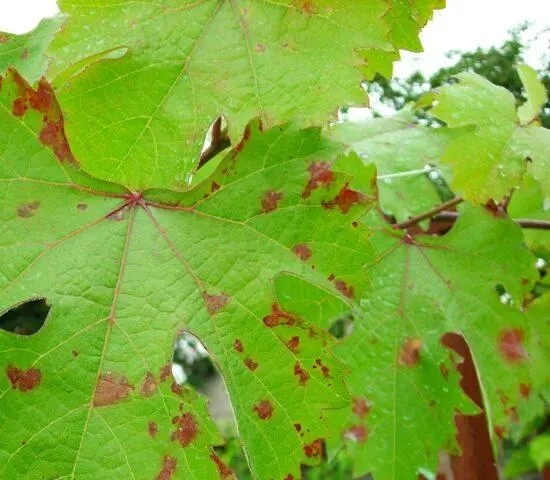
Copper sulfate is a simple and effective way to prevent diseases
Why grapes are treated with copper sulphate
Processing grapes with a solution of copper sulfate is one of the most affordable ways to provide it with the necessary trace elements and protect it from fungal infection. The timing of the activities and the dosage of the drug are determined depending on the task.
Additional fertilizing
Fertilizing grapes with copper sulphate helps to make up for the deficiency of copper, which is necessary to increase resistance to diseases and normalize the photosynthesis process on depleted sandy and clay soils.
The main signs of a lack of an element in the soil:
- yellowing of the leaves and the appearance of white tips;
- growth retardation of young shoots;
- the appearance of symptoms of fungal diseases.
If one or more alarming signs appear, it is recommended to treat the grapes with copper sulphate on the leaves in the proportion indicated in the instructions for the preparation.
Processing of cuttings and seedlings
According to experts, it is young chubuks, whose immunity still leaves much to be desired, that are most susceptible to the effects of a fungal infection. Processing grape planting material with a 3% solution of copper sulfate helps to facilitate the adaptation of cuttings and seedlings in a new place. The procedure reduces the likelihood of developing diseases characteristic of this culture.
To treat grape cuttings with copper sulphate, they are sprayed with a pre-prepared solution or dipped into it for ten seconds.
Wound disinfection
Fresh cuts on the vine are an open gate for infection. Treatment of wounds with copper sulphate will help prevent the development of diseases. To prepare a disinfectant solution, 50 g of dry matter is diluted in 1 liter of warm water.
Treatment and prevention of diseases
Copper sulfate is an effective tool for the prevention and treatment of fungal diseases of grapes.
Treating plants with this fungicide will help prevent the development of:
- white and brown spotting;
- powdery mildew;
- scab;
- all types of rot;
- mildew;
- mycosis, etc.
The processing of grapes with copper sulphate also helps in pest control.
For preventive and therapeutic treatment of the vine, the so-called “adhesive” is added to the copper sulphate solution, which will help the drug stay longer on the surface of the plants. In this capacity, you can use any synthetic detergent or skim milk.
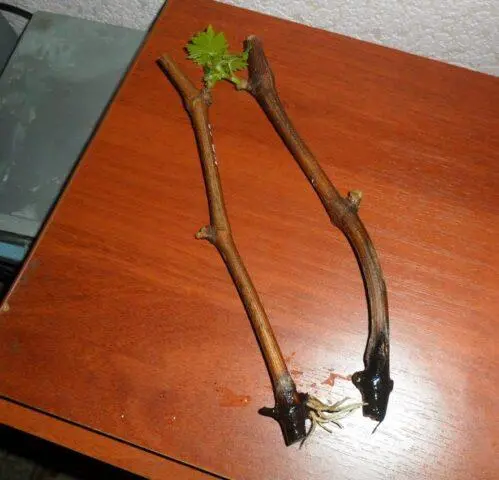
After processing, the cuttings take root faster
How to dilute copper sulfate for processing grapes
An important rule for preparing a means of copper sulfate for processing grapes is the observance of proportions:
- 1 g of a dry preparation per 1 liter of water is a highly concentrated solution that can only be used for the autumn sanitation of an old vine;
- for the preventive treatment of grapes in the spring, a less concentrated agent is made at the rate of 1 g of a chemical per 1 liter of water at room temperature;
- for top dressing, an aqueous solution of CuSO4 is used, prepared at the rate of 5 g of dry powder per 10 liters of warm water.
In the process of treating fungal diseases, Bordeaux mixture is used, which includes CuSO4 and lime milk. This preparation can be purchased at any garden store or prepared independently by combining an aqueous solution of copper sulphate with a solution of lime filtered through a fine sieve.
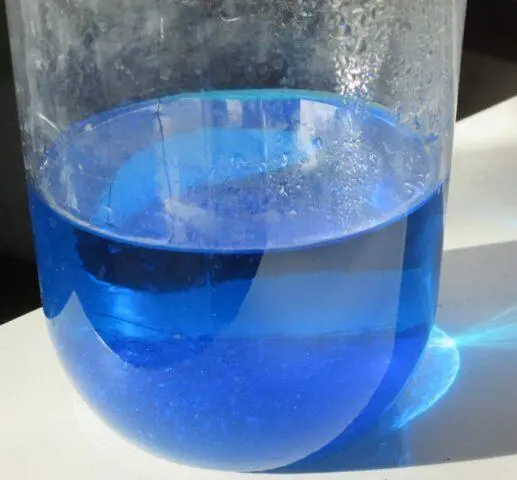
Experts do not recommend preparing a solution in large volumes
When to process grapes with copper sulfate
The grape processing time is determined depending on the purpose of the event:
- autumn – rehabilitation of the vine (destruction of pathogenic microorganisms and harmful insects);
- spring – repeated preventive treatment and top dressing;
- summer – feeding and treatment of diseases.
In special cases, the timing of preventive and therapeutic measures may be slightly shifted.
Spraying grapes with blue vitriol in autumn
Sanitary treatment of grapes with copper sulfate in the fall is carried out before shelter from the winter cold, that is, when the crop is fully harvested and the leaves fall. It’s around mid-November.
Before spraying the grapes in autumn with copper sulfate, the soil in the root zone of the bush is cleaned of fallen leaves and damaged branches, and the vine itself is tied into bundles and sprayed with a pre-prepared 5% solution of copper sulfate.
You need to start spraying the grapes from the upper tier, gradually moving to the lower branches. Lastly, the trunk and elements of the supporting structure are treated, which can also be carriers of the infection.
A sprayer with a small liquid reservoir is suitable for processing small bushes. If you have to process a large vineyard, it is better to use a backpack sprayer model with a large tank.
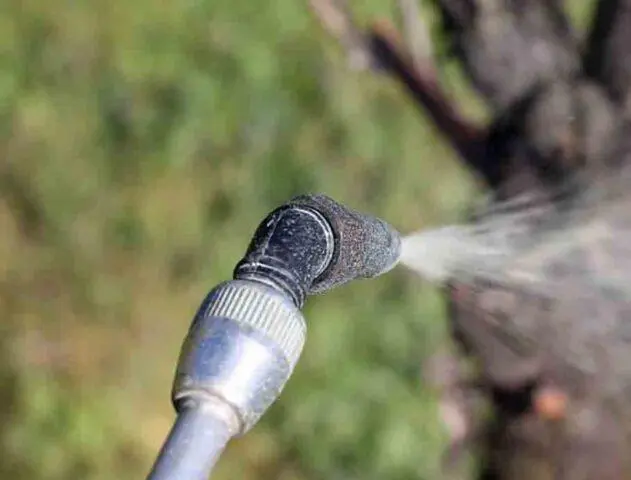
To process one bush, about 1,5 liters of solution will be required.
Treatment of grapes with copper sulphate in spring
Preventive spraying of grapes with copper sulphate in the spring must be carried out before the leaves appear. Ideally, do this when the thermometer needle stops at +5 ° C. In the southern regions of the country, this is approximately the end of February, the beginning of March, and in the middle lane – the middle to the end of March.
During work:
- open the vine (remove winter shelter);
- raise the shoots on the trellis and leave to dry in the sun for a couple of days;
- when the shoots dry properly, the grapes are treated with a 1% CuSO solution prepared that day
The working solution is not subject to storage, therefore it is recommended to prepare it as much as it is planned to use per day.
If for some reason it was not possible to take care of the prevention of diseases in early spring, you can spray the grapes before flowering. The procedure is performed in the usual way, that is, from top to bottom.
Mid and late spring is a good time for root feeding. You can determine the deficiency of copper by the color of the leaves, which is uncharacteristic for this crop, as well as the weakness and thinning of the shoots.
When performing root top dressing, it is desirable to exclude contact of the drug with the soil. For example, close it in the root zone for the duration of the procedure with a film.
Summer processing of grapes with copper sulphate
In summer, it is not recommended to use copper sulfate without special need. The fact is that high air temperature combined with exposure to hydrochloric acid can cause burns on the leaves.
The exception is:
- Treatment of diseases – in this case, use a 0,5% solution of copper sulfate. In the presence of obvious signs of lichen or odium, an increase in the concentration of the drug to 3% is allowed.
- Top dressing of grapes on a leaf (if spring root dressing was skipped). In this case, the vine and leaves are sprayed with a 0,2–0,3% solution of copper sulfate.
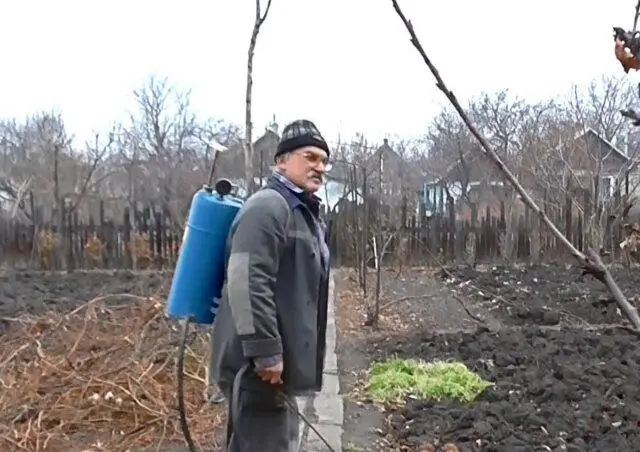
Spring processing is carried out immediately after the snow melts.
Safety regulations
Considering that copper sulfate is a toxic substance, when interacting with it, certain safety rules should be observed:
- Work in special clothing that protects the skin from contact with the chemical. Ideally, put on rubberized overalls or a waterproof raincoat over ordinary clothes, and high rubber shoes on your feet;
- Special rubberized gloves are put on the hands, and after work it is important to wash them with soap and water.
- Hair can be protected with a headgear, and respiratory organs with a respirator or an individual mask. Special or regular sunglasses will help prevent drops from getting into your eyes.
- You can work with a solution of copper sulfate only on a dry, calm day. Ideally, do this in the morning or evening.
- If a high concentration of a solution comes into contact with the skin, it can cause a burn. In case of contact with a chemical, immediately rinse the affected area with running water and treat with a disinfectant. If there are signs of irritation or burns, it is recommended to consult a doctor.
Compliance with these simple rules will make the procedure for processing grapes safe for health.
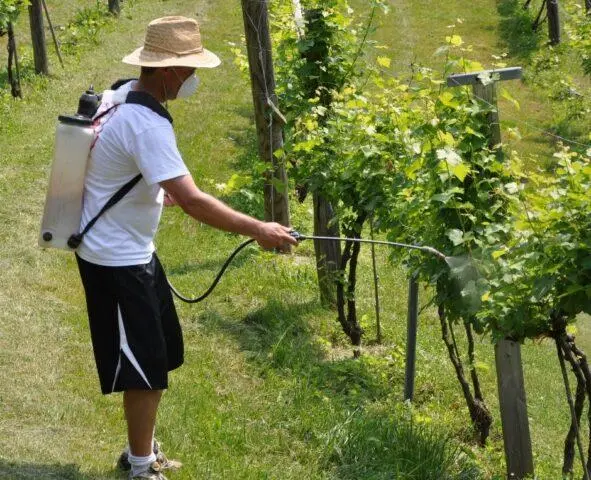
The respirator will protect the respiratory tract from chemicals
Compatibility with other drugs
Copper sulphate cannot be combined in common solutions with organophosphorus insecticides. It is also incompatible with other drugs that tend to decompose in an alkaline environment.
Conclusion
Copper sulfate for grapes in the correct proportions will help protect the vine and berries from diseases throughout the growing season without disturbing the growth and fruiting processes. And the use of personal protective equipment will make the processing of grapes safe for human health.









